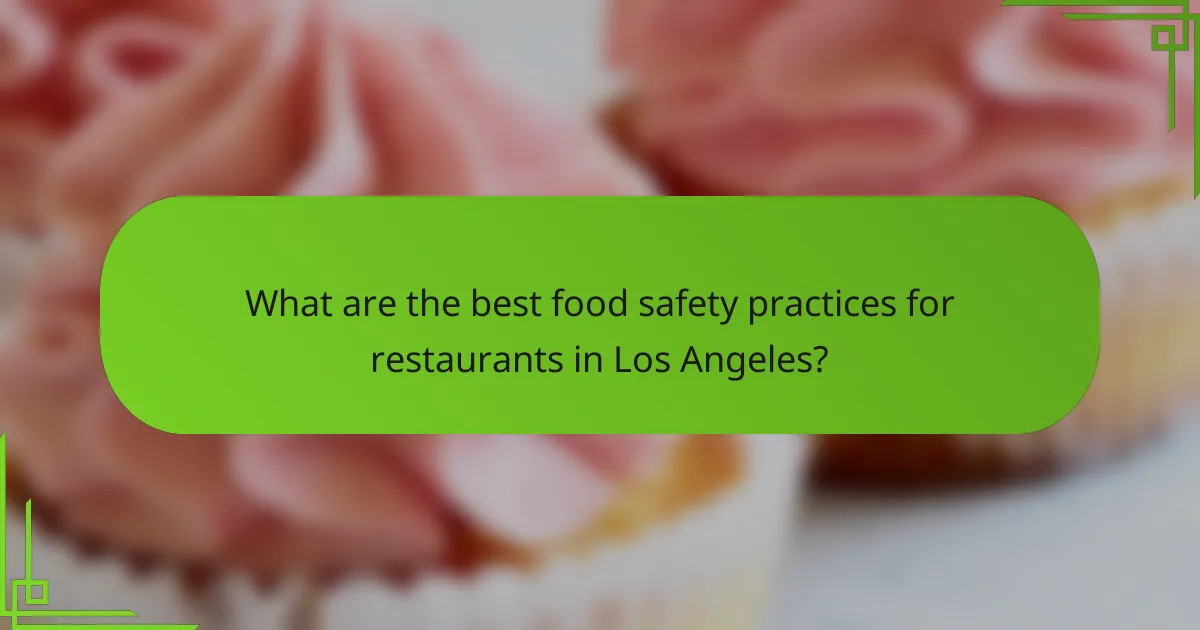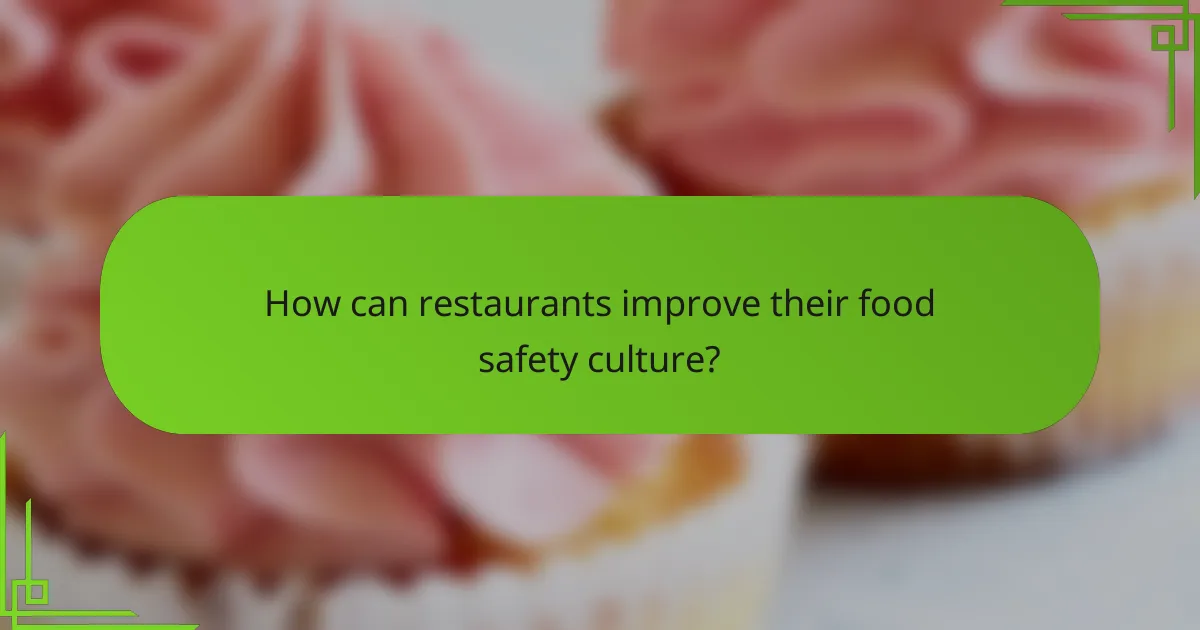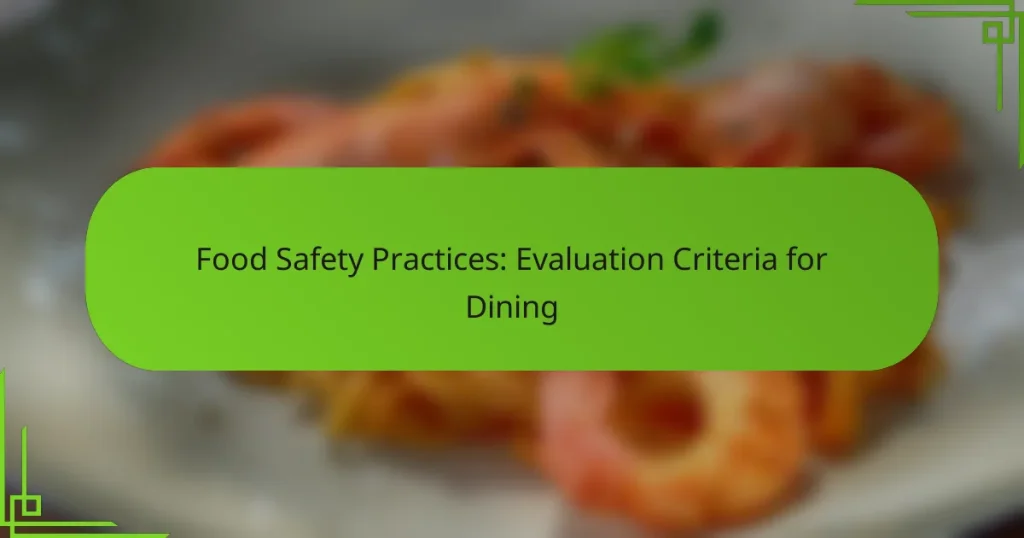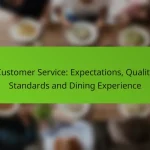Ensuring food safety in dining establishments is crucial for protecting public health and maintaining customer trust. Effective practices, such as employee training, proper food storage, and routine inspections, are essential for compliance with health regulations. By regularly evaluating these practices through self-assessments and third-party audits, restaurants can identify areas for improvement and enhance their overall food safety standards.

What are the best food safety practices for restaurants in Los Angeles?
The best food safety practices for restaurants in Los Angeles include regular employee training, proper food storage techniques, routine kitchen inspections, effective pest control measures, and temperature monitoring systems. Implementing these practices helps ensure compliance with local health regulations and protects customer health.
Regular employee training
Regular employee training is essential for maintaining food safety standards in restaurants. Staff should receive training on hygiene, safe food handling, and the importance of following health regulations. Training sessions should be conducted at least annually, with refresher courses as needed to address any updates in local laws or best practices.
Consider using a mix of in-person training and online modules to accommodate different learning styles. Engaging employees with hands-on demonstrations can reinforce their understanding of proper food safety techniques.
Proper food storage techniques
Proper food storage techniques are crucial for preventing foodborne illnesses. Foods should be stored at appropriate temperatures, with perishables kept below 40°F (4°C) and hot foods maintained above 140°F (60°C). Implementing a first-in, first-out (FIFO) system helps ensure that older stock is used before newer items.
Labeling food containers with dates and contents can help staff quickly identify what needs to be used or discarded. Regular checks of inventory can prevent spoilage and waste.
Routine kitchen inspections
Routine kitchen inspections help identify potential hazards and ensure compliance with health codes. Inspections should be conducted weekly or bi-weekly, focusing on cleanliness, equipment functionality, and food handling practices. Keeping a checklist can streamline the inspection process and ensure that all areas are covered.
Encouraging staff to report any issues immediately can foster a culture of safety and accountability. Addressing problems promptly can prevent them from escalating into more significant health risks.
Effective pest control measures
Effective pest control measures are vital for maintaining a safe dining environment. Restaurants should implement a comprehensive pest management plan that includes regular inspections and treatments by licensed professionals. Keeping food storage areas clean and sealed can help deter pests from entering the premises.
Establishing a proactive approach, such as monitoring for signs of infestations and addressing them quickly, can minimize the risk of pest-related health issues. Staff should be trained to recognize potential pest problems and report them immediately.
Temperature monitoring systems
Temperature monitoring systems are essential for ensuring that food is stored and cooked at safe temperatures. Using digital thermometers and temperature logs can help staff track food temperatures accurately. Regular calibration of thermometers ensures their accuracy and reliability.
Consider investing in automated temperature monitoring systems that alert staff to temperature fluctuations in real-time. This can help prevent food spoilage and reduce the risk of foodborne illnesses, ensuring compliance with local health regulations.

How can restaurants evaluate their food safety practices?
Restaurants can evaluate their food safety practices through self-assessments, third-party audits, and customer feedback mechanisms. These methods help identify strengths and weaknesses in food handling and hygiene, ensuring compliance with health regulations and enhancing customer trust.
Conducting self-assessments
Self-assessments involve regular internal evaluations of food safety protocols and practices. Staff can use checklists to review areas such as food storage temperatures, cleanliness, and employee hygiene. This proactive approach allows restaurants to identify and address potential issues before they escalate.
To conduct effective self-assessments, establish a routine schedule, such as weekly or monthly reviews. Encourage staff participation to foster a culture of accountability and awareness regarding food safety standards.
Utilizing third-party audits
Third-party audits provide an objective evaluation of a restaurant’s food safety practices. Engaging external auditors can help identify compliance gaps with local health regulations and industry standards. These audits often include comprehensive inspections and detailed reports with actionable recommendations.
Consider scheduling third-party audits annually or biannually to maintain high standards and improve practices. This external validation can enhance credibility with customers and regulatory bodies alike.
Implementing customer feedback mechanisms
Customer feedback mechanisms, such as surveys or comment cards, can provide valuable insights into perceived food safety practices. Encouraging customers to share their experiences helps identify areas needing improvement, from food quality to cleanliness.
To effectively gather feedback, make it easy for customers to provide their thoughts, perhaps through digital platforms or follow-up emails. Regularly review this feedback and take action on common concerns to demonstrate commitment to food safety and customer satisfaction.

What regulations govern food safety in California?
Food safety in California is primarily governed by state regulations that ensure the safe handling, preparation, and storage of food in various establishments. These regulations are designed to protect public health and include guidelines from the California Retail Food Code, local health department standards, and food safety certification requirements.
California Retail Food Code
The California Retail Food Code (CRFC) sets the baseline for food safety practices in retail food establishments throughout the state. It outlines requirements for food handling, employee hygiene, equipment sanitation, and food storage temperatures to minimize the risk of foodborne illnesses.
Establishments must comply with specific provisions, such as maintaining food at safe temperatures (typically below 41°F or above 135°F) and ensuring that food contact surfaces are sanitized. Regular inspections by local health departments enforce these standards, helping to maintain compliance.
Local health department guidelines
Local health departments in California implement additional food safety guidelines tailored to their communities. These guidelines may include specific regulations regarding food sourcing, preparation methods, and waste disposal practices that align with local health concerns.
Establishments should familiarize themselves with their local health department’s requirements, as they can vary significantly. Regular communication with local health officials can help ensure compliance and address any emerging food safety issues effectively.
Food safety certification requirements
Food safety certification is often required for food handlers and managers in California. This typically involves completing a food safety training program and passing an exam to demonstrate knowledge of safe food handling practices.
Certification programs, such as those offered by the National Restaurant Association or ServSafe, are widely recognized. Establishments should ensure that their staff members are certified, as this not only meets regulatory requirements but also enhances overall food safety and customer trust.

What are the common food safety violations in dining establishments?
Common food safety violations in dining establishments include improper food handling, cross-contamination issues, and inadequate cooking temperatures. These violations can lead to foodborne illnesses and pose serious health risks to customers.
Improper food handling
Improper food handling refers to the failure to maintain safe practices during food preparation and service. This includes not washing hands properly, not using gloves when necessary, and failing to keep food at safe temperatures. Establishments should ensure that staff are trained in proper hygiene and handling techniques.
For example, food workers should wash their hands for at least 20 seconds with soap and water before handling food. Regular training sessions can help reinforce these practices and reduce the risk of contamination.
Cross-contamination issues
Cross-contamination occurs when harmful bacteria or allergens are transferred from one food item to another, often through shared utensils or surfaces. This can happen when raw meats are prepared on the same cutting board as vegetables without proper cleaning in between. To prevent this, separate equipment and surfaces should be used for different food types.
Establishments should implement a color-coded system for cutting boards and utensils to minimize the risk of cross-contamination. Regular audits can help ensure compliance with these practices.
Inadequate cooking temperatures
Inadequate cooking temperatures can allow harmful bacteria to survive in food, leading to foodborne illnesses. Each type of food has a recommended minimum internal temperature that must be reached to ensure safety. For instance, poultry should be cooked to at least 74°C (165°F), while ground meats should reach 71°C (160°F).
Using a food thermometer is essential for verifying that food has been cooked to the proper temperature. Staff should be trained to check temperatures regularly and maintain logs to track compliance with safety standards.

How can restaurants improve their food safety culture?
Restaurants can enhance their food safety culture by prioritizing training, fostering open communication, and implementing regular safety audits. A strong culture emphasizes accountability and continuous improvement, ensuring that all staff understand the importance of food safety practices.
Training and Education
Effective training programs are essential for instilling food safety practices among restaurant staff. Regular workshops and refresher courses can keep employees informed about the latest safety protocols and regulations. Consider using interactive methods, such as role-playing scenarios, to engage staff and reinforce learning.
New hires should undergo comprehensive onboarding that covers food handling, sanitation, and allergen awareness. Ongoing education can help maintain high standards and adapt to any changes in food safety regulations.
Open Communication
Encouraging open communication about food safety issues can significantly enhance a restaurant’s safety culture. Staff should feel comfortable reporting concerns without fear of reprimand. Establishing regular meetings to discuss safety practices and incidents can promote transparency and collective responsibility.
Utilizing suggestion boxes or anonymous reporting systems can also help gather feedback and identify areas for improvement. Recognizing and rewarding staff who proactively address safety concerns can further reinforce a culture of safety.
Regular Audits and Assessments
Conducting regular food safety audits is crucial for identifying potential risks and ensuring compliance with health regulations. These assessments should evaluate food storage, preparation areas, and employee hygiene practices. Aim for both scheduled and surprise inspections to maintain vigilance.
Utilizing checklists during audits can streamline the process and ensure comprehensive evaluations. After each audit, share results with the team and develop action plans to address any identified issues, fostering a continuous improvement mindset.


